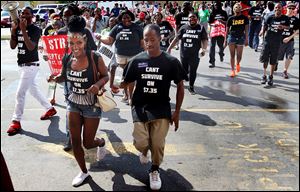
Pair of studies feed wage debate
More than half of workers at fast-food chains get aid
Pair of studies feed wage debate
10/15/2013
Demonstrators rally outside a Wendy’s fast food restaurant in Rock Hill, Mo. During the last year, fast-food workers and other lower-paid employees have been protesting and staging ministrikes.
WASHINGTON — Taxpayers are spending nearly $7 billion a year to supplement the wages of fast-food workers, even as the leading fast-food companies earn billions of dollars in annual profits, according to a pair of reports released Tuesday.
More than half of the nation’s 1.8 million “core” fast-food workers rely on the federal safety net to make ends meet, the reports said. Together, they collect nearly $1.9 billion through the earned income tax credit, $1 billion in food stamps, and $3.9 billion through Medicaid and the Children’s Health Insurance Program, according to a report by economists at the University of California at Berkeley’s Labor Center and the University of Illinois.
Overall, the “core” fast-food workers are twice as likely to rely on public aid than workers in other fields, said one of the reports, which examined nonmanagerial fast-food employees who work at least 11 hours a week and 27 weeks a year.
The report immediately raised the ire of some conservative groups that said it used faulty methodology to prove a point.
“In its quest to unionize the fast-food industry, the [Service Employees International Union] has demonstrated that it will leave no stone unturned — including using ‘research’ and arguments that would get a higher grade in creative writing than in a high school economics class,” said Michael Saltsman, research director at conservative think tank Employment Policies Institute, in a statement.
The economists’ report says that even among the 28 percent of fast-food workers who were on the job 40 hours a week, the report said, more than half relied on the federal safety net to get by.
“These statistics paint a picture of workers not being able to get their fair share of the largest, richest economy in the world,” said Sylvia Allegretto, lead author of the report by the university economists. “It is a good thing that we have these work supports, but they should be a last resort.”
Those workers rely on the public safety net even though the nation’s seven largest publicly traded fast-food companies netted a combined $7.4 billion in profits last year, while paying out $53 million in salaries to their top executives and distributing $7.7 billion to shareholders, according to a second report by the National Employment Law Project, a worker advocacy group.
The reports lend academic support to the growing activism among fast-food workers, poorly paid employees of federal contractors, and other low-wage workers, who have been seeking raises to as much as $15 an hour and an easier route to forming unions.
Fast-food industry representatives say raising wages for cooks, cashiers, and drive-through window workers — who earn a median wage of $8.69 an hour, according to the report by the Illinois and Berkeley economists — would lead to fewer jobs overall. Also, they say, the franchisees who own many fast-food restaurants have thin profit margins. Dramatically raising wages would force them out of business.
But advocates for fast-food workers say the new reports show that the fast-food industry generates substantial profits that are distributed inequitably. Moreover, they said, the low wages of fast-food workers leave taxpayers taking up the slack.
“I think what the report does is separate myth from reality,” said Jack Temple, a policy analyst who is the author of the report by National Employment Law Project. “There are plenty of resources to change this business model that involves workers having to rely on public assistance to make ends meet.”